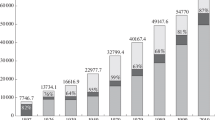Abstract
Presented are the results from analyzing the dynamics of the ethnic mosaic index of the Russian regions between the population censuses of 1959 and 2010, with a division into two periods: the late Soviet period (until 1989) and the post-Soviet era. In the late Soviet period, the growth of polyethnicity embraced 55% of the regions of the RSFSR. They were mostly Russian regions that experienced an influx of migrants mainly from Ukraine and Belarus as well as from other Union Republics and a number of national autonomies of Russia. Already then most of the autonomous republics showed a tendency for an increase in the share of the population of titular enthnicity. In the post-Soviet period, in spite of the ongoing decline in the Russian population in Russia, most regions of the country (71%) experienced a decree of the degree of homogeneity of the ethnic composition of the population. This category included many “Russian” regions where a markedly reduced share of the Russian and Belarusian population was never compensated for by the influx of migrants from North Caucasus and the Baltics and the CIS. From the previously extensive territorial massif with increasing polyethnicity in the center of the European part of the country there were only a few regions left in the post-Soviet period, which formed a ring around Moscow. In this situation, Moscow itself began to play the assimilation function with respect to foreign-language-speaking migrants of the Soviet and post-Soviet periods. Most of the national republics showed a steady increase in the share of titular ethnic groups, including the indrawal of a given ethnic group to within the boundaries of the autonomy accompanied by an outflow of Russians. Only in a few republics (Karelia, Komi, Udmurtia and Khakassia) and a number of autonomous okrugs) did the proportion of the Russian population increase.
Similar content being viewed by others
References
Ekkel’, B.M., Determination of the Mosaic Index of National Composition of the USSR Republics, Krais and Oblasts, Sov. Etnografiya, 1976, no. 2, pp. 33–39 [in Russian].
Belozerov, V.S., Ethnic Map of the North Caucasus, Moscow: OGI, 2005 [in Russian].
Lysenko, A.V., Vodopyanova, D.S. and Azanov, D.S., Ethnocontact Zones in the System of Ethnocultural Regionalization of the North Caucasus, Nauka. Innovatsii. Tekhonologii, 2013, no. 1, pp. 130–137 [in Russian].
Nabieva, U.N., Cultural Geography of Dagestan, Moscow: Izd. Inst. Naslediya, 2002 [in Russian].
Chichichin, V.V. and Belozerov, V.S., Ethnic Map of the Stavropol Region: Spatio-Temporal Dynamics Over the Last Half Century, Regeional’nye Issledovaniya, 2015, no. 4 (50), pp. 113–119 [in Russian].
Pelina, A.N., Geoinformation Mapping of Ethnodemographic Indicators (A Case Study of Krasnodar Krai), in Geographical Research in Krasnodar Krai: Collection of Scientific Papers, Krasnodar: Izd. Kuban. Univ., 2007, pp. 201–209 [in Russian].
Sidorenko, N.A., Ethnic Mosaic Structure in the Realities of the Ethno-Social History of Crimea of the 20th Century, V Mire Nauchnykh Otkrytii, 2015, no 3–6 (63), pp. 2798–2808 [in Russian].
Filimonova, I.Yu., Structure and Development of Confessional Space of Orenburg Oblast, Extended Abstract of Cand. Sci. (Geogr.) Dissertation, St. Petersburg, 2006 [in Russian].
Shitikov, F.V., Geographical Characteristics of the Ethno-Confessional Situation on the Territory of the Republic of Buryatia, Izv. Irkutsk Univ., Ser. Nauki o Zemle, 2015, vol. 11, pp. 141–148 [in Russian].
Degteva, J.F., The Spatial Organization and Dynamics of the Ethnic Structure of Yakutia, Regiona’nye Issledovaniya, 2015, no. 4 (50), pp. 99–105 [in Russian].
Manakov, A.G., Dynamics of the Ethnic Mosaic Structure on the Territory of Northwestern Russia During 1897–2010, Regional’nye Issledovaniya, 2016, no. 2 (52), pp. 72–83 [in Russia].
Manakov, A.G., Dynamics of the National Population Structure of Northwestern Russia During 1939–2010, Pskov. Regionolog. Zhurn., 2016 no. 3 (27), pp. 74–96 [in Russian].
Manakov, A.G., Changes in National Population Structure of Northwestern Russia From 1897 to 1959, Pskov. Regionol. Zhurn., 2016, no. 2 (26), pp. 62–87 [in Russian].
Orlov, A.Yu., The Historical-Geographical Aspects of Transformation of Ethnic Structure of the Russian Federation, Regional’nye Issledovaniya, 2013, no. 2 (40), pp. 120–124 [in Russian].
Safronov, S., Russian Population Ethnic Structure: Trends and Transformations, Baltic Region, 2015, no. 3 (25), pp. 106–120.
All-Russian 2010 Population Census. The Population: Ethnicity, Gender and Subjects of the Russian Federation. URL: http://demoscope.ru/weekly/ssp/rus_etn_10.php?reg=1 (Accessed July 25, 2017) [in Russian].
All-Russian 1959 Population Census. Ethnic Population Structure for Regions of Russia. URL: http://www.demoscope.ru/weekly/ssp/rus_nac_59.php (Accessed July 25, 2017) [in Russian].
All-Russian 1989 Population Census. Ethnic Population Structure for Regions of Russia. URL: http://www.demoscope.ru/weekly/ssp/rus_nac_89.php (Accessed July 25, 2017) [in Russian].
Streletskii, V.N., Russia in Ethnocultural Dimension: Regionalization Factors and Spatial Structures, in Regional Development and Regional Policy of Russia During the Transitional Period, S.S. Artobolevskii and O.B. Glezer, Eds., Moscow: Izd. MGTU im. N.E. Baumana, pp. 146–176 [in Russian].
Sushchii, S.Ya. and Druzhinin, A.G., Some Outlines of the Geography of Russian Culture, Rostov-on-Don: Izd. SKNTs VSh, 1994 [in Russian].
Author information
Authors and Affiliations
Corresponding author
Additional information
Russian Text © A.G. Manakov, 2019, published in Geografiya i Prirodnye Resursy, 2019, Vol. 40, No. 2, pp. 13–21.
Rights and permissions
About this article
Cite this article
Manakov, A.G. Spatial Patterns in the Transformation of the Ethnic Structure of the Russian Population Between the 1959 and 2010 Censuses. Geogr. Nat. Resour. 40, 106–114 (2019). https://doi.org/10.1134/S1875372819020021
Received:
Published:
Issue Date:
DOI: https://doi.org/10.1134/S1875372819020021




